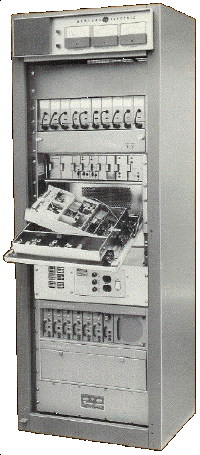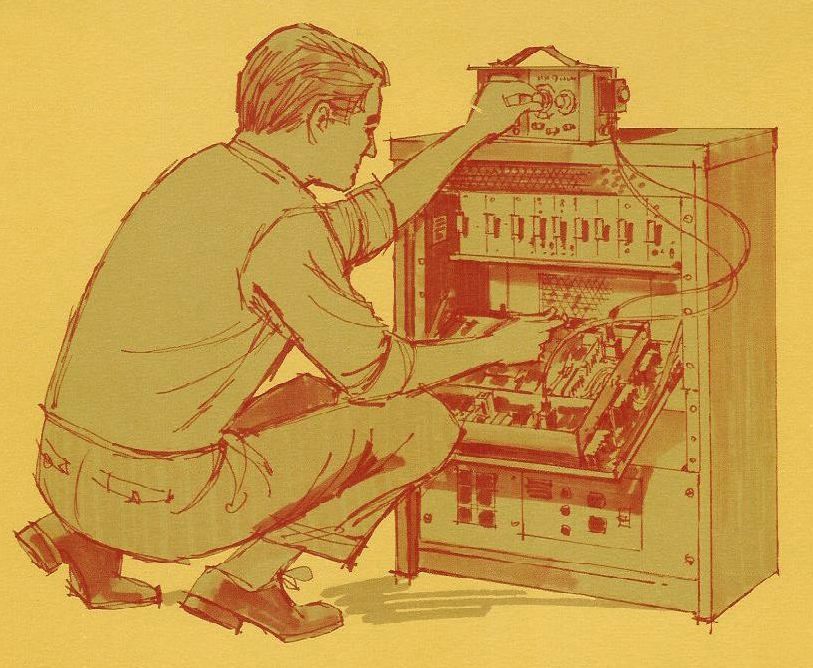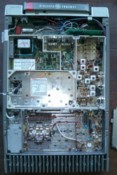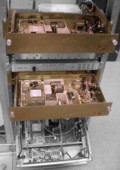|
From the outset,
BeachNet
Repeater System has standardized on the General Electric (GE) Mastr-II (yes, it's spelled that way) line of Land Mobile, two-way radio equipment for its repeaters, as well as auxiliary receivers, and some links. This was the first all solid-state equipment produced by GE for the commercial market. Their previous lines, the "Mastr" and "Mastr Pro", used vacuum tubes, at least in the final amplifier assembly. The obvious advantages of an all solid-state design are lower power consumption (higher efficiency) and longer service life. The service life was to prove quite long indeed, partly due to a very conservative engineering approach. These radios are built - or should I say "over-built" - like a battleship.
 With
a multi-site system, like ours, it is desirable to standardize the equipment and construction techniques as much as possible. This makes life a lot easier on a number of fronts. The circuits become familiar, as do the parts and pieces, making troubleshooting easier. There are fewer variables when shopping for spare parts, and one set of spares can cover for possible failures at a number of sites, reducing the inventory required to be able to repair break-downs in a timely manner. Since this system was constructed on a shoestring budget, we opted for used equipment. When deciding on a particular brand, a number of factors come into play. The brand should be as reliable as possible. It should be a product line that sold widely, so that the gear will be readily available on the surplus market. Importantly, the documentation for the equipment must be available. With
a multi-site system, like ours, it is desirable to standardize the equipment and construction techniques as much as possible. This makes life a lot easier on a number of fronts. The circuits become familiar, as do the parts and pieces, making troubleshooting easier. There are fewer variables when shopping for spare parts, and one set of spares can cover for possible failures at a number of sites, reducing the inventory required to be able to repair break-downs in a timely manner. Since this system was constructed on a shoestring budget, we opted for used equipment. When deciding on a particular brand, a number of factors come into play. The brand should be as reliable as possible. It should be a product line that sold widely, so that the gear will be readily available on the surplus market. Importantly, the documentation for the equipment must be available.
In the beginning, we bought a few mobile radios and started building. Our first repeaters were "Mobile Conversions" (more on this later) of the GE Mastr-II. The first link radio wa
s a Motorola. There was some difficulty getting this radio programmed and we never located a manual for it. Now, don't get me wrong, Motorola makes a great product, but programing software and documentation is not as available. After some experience with these and other radios of various brands, we settled on the Mastr-II as the best model for our particular application.
Pacific and Grays Harbor counties have employed Mastr-II gear for their public safety radio systems for many years. As fortune would have it, after our project was well under way, and the benefits of having such an Emergency Communications system in place were becoming apparent, we began to receive surplus Mastr-II equipment, a few pieces at a time, from each of these entities. We also received donated equipment from the Naselle and Federal Way Fire Departments. Many Agencies were upgrading their equipment in anticipation of the 2013 deadline for narrow-band conversion by Part 90 operators. The timing could not have been better for us. It is a happy coincidence that they had used the same line on which we had decided.
In the early days of solid-state design, power transistors were somewhat fragile, and the engineers designing a line of equipment to be sold widely wanted to ensure they were not creating a "warranty nightmare", in spite of having limited experience in the relatively new technology. They knew that tubes were more forgiving to mismatched loads than the then-available solid-state devices, and customers were used to tubes commonly being replaced in normal service, sometimes often. Transistors are expensive to replace, so the new design had to be "bullet proof". In order to ensure that these radios would operate at least as well as the predecessors, they were carefully engineered to stand up to a good deal of abuse. The fact that most of our equipment has been operating for thirty years or more is a testament to the design skill of those engineers. The Mastr-II line was designed between 1970 and 1972, and went on sale in 1972. The product line was finally discontinued in 1993.
The Mastr-II is
available in "Station" and "Mobile" configurations. The Station
is designed to mount into a standard 19-inch relay rack. The receiver and exciter
are mounted into the fold-down drawer, in individual shielded boxes. The power
amplifier is in its own shielded box in the back of the cabinet with an over-size
heatsink. The units can be rated for continuous duty and work well in repeater
service due to the extensive shielding.
These units will also bolt into the standard line of GE cabinets.
The mobile units use the same internal modules, and therefore can be a good
supply of spare parts. For every Station model sold, several dozen Mobile
units went out the factory door. That makes them relatively inexpensive on
the eBay market. While it is certainly possible to convert a mobile unit to
operate full-duplex, and use it as a repeater, there are several disadvantages
to this. The shielding between the transmitter and receiver is much less,
promoting desense. The heatsink is much smaller with a longer thermal path,
making them only able to withstand low-duty-cycle service at reduced power.
The internal 10-volt power supply was designed to power the transmitter OR
the receiver, not both at the same time.
GE Mastr-II radios were
very popular in the Public Safety and Land Mobile radio services. They were also
widely used in support of Government and Marine applications. With twenty years
of supplying those industries, there were many units sold.
 The
Station has a pull-down front door (called the "drawer") that contains
the
receiver and the transmitter exciter. The original-equipment GE CTCSS decode board plugs in here on the "Station Board". GE produced several generations of CTCSS boards, with various methods of tone selection, starting with models that required individual single-tone "Versatone" resonators, then PROMs, EPROMs, and finally boards with DIP-switch selection for the tone. Some of these boards were single-tone, and some had eight-tone capability to match the channel capacity of these radios. Some of these boards are encode-only; some are decode-only; and some are able to encode and decode. These boards require a fairly high CTCSS level, on the order of one kilo-Hertz deviation, to operate well. Although this is normal in a commercial setting, Amateur systems generally run a lower tone level, in the range of 300 to 500 Hz, leaving more "headroom" for the voice portion of the audio signal. Under these conditions, I have found the Communications Specialists TS-64-ds encoder/decoder to give superior service. The TS-64 can be mounted on the Service Board in the drawer, and wired in as the original GE board would have operated. Alternatively, the TS-64 can be mounted on the Audio card on the card shelf in the repeater cabinet. This location has all necessary hook-ups available and is cleaner than mounting on the Service Board. The
Station has a pull-down front door (called the "drawer") that contains
the
receiver and the transmitter exciter. The original-equipment GE CTCSS decode board plugs in here on the "Station Board". GE produced several generations of CTCSS boards, with various methods of tone selection, starting with models that required individual single-tone "Versatone" resonators, then PROMs, EPROMs, and finally boards with DIP-switch selection for the tone. Some of these boards were single-tone, and some had eight-tone capability to match the channel capacity of these radios. Some of these boards are encode-only; some are decode-only; and some are able to encode and decode. These boards require a fairly high CTCSS level, on the order of one kilo-Hertz deviation, to operate well. Although this is normal in a commercial setting, Amateur systems generally run a lower tone level, in the range of 300 to 500 Hz, leaving more "headroom" for the voice portion of the audio signal. Under these conditions, I have found the Communications Specialists TS-64-ds encoder/decoder to give superior service. The TS-64 can be mounted on the Service Board in the drawer, and wired in as the original GE board would have operated. Alternatively, the TS-64 can be mounted on the Audio card on the card shelf in the repeater cabinet. This location has all necessary hook-ups available and is cleaner than mounting on the Service Board.
 The Mastr-II receiver is crystal controlled and incorporates a 5-stage helical resonator front-end, in a large tin-plated block (that also houses the mixer), providing superior selectivity. The tin plating on this component has a habit of growing "tin-whiskers" that can cause problems. It takes moisture and time for these to grow, but in our case, there has been plenty of time. Fortunately, there is a "fix" for this problem. The filter is disassembled down to the tin-plated casting, which is carefully cleaned with a lint-free cloth and alcohol. This is finished with a clear coat of spray-on Krylon, and the filter reassembled. The Mastr-II receiver is crystal controlled and incorporates a 5-stage helical resonator front-end, in a large tin-plated block (that also houses the mixer), providing superior selectivity. The tin plating on this component has a habit of growing "tin-whiskers" that can cause problems. It takes moisture and time for these to grow, but in our case, there has been plenty of time. Fortunately, there is a "fix" for this problem. The filter is disassembled down to the tin-plated casting, which is carefully cleaned with a lint-free cloth and alcohol. This is finished with a clear coat of spray-on Krylon, and the filter reassembled.
Designed for a total receiver bandwidth of about 1-MHz, in repeater service this "bullet proof" front end affords protection from out-of-band interference and desense. The transmitter exciter is also crystal-controlled, and generally a Phase-Modulated, multiplier design. The later model exciters used a direct FM, Phase-Locked-Loop (PLL) design that is better for repeater use, with less sideband noise and a cleaner signal. The exciter puts out approximately 200 mW to the power amplifier.
The Station transmitter power amplifier and its heatsink are mounted at the rear of the cabinet. These come in several power levels ranging up to 110-watts, and in both Intermittent-Duty and Continuous-Duty versions. The Continuous-Duty heatsink is huge, one more example of conservative engineering. If using the Intermittent-Duty power amplifier in repeater service, the power level should be backed off to no more than 60% of the rated power, and fans fitted to cool the heatsink. Our policy is not to run even the Continuous-Duty amplifiers at more than 80% of rated power, in deference to their age and in the interests of longevity. Many repeater-model power amplifiers have a "Z-matcher" device on the output, a nice option. This is a tiny antenna tuner that matches the output impedance of the amplifer to the load impedance. GE noticed that some transmitters, looking into a duplexer or other non-linear, reactive load, would repeatedly burn up power amplifiers. The "Z-matcher", if carefully adjusted, will cure this impedance mis-match problem.
 Many Mastr-II Stations were originally set up as base station transceivers, rather than true repeaters. Although they can be easily converted, the output situation on the different models differs significantly. In stations intended for base station use, the output of the power amplifier includes a transmit/receive relay, and a single antenna port. Power amplifiers intended for repeaters have no switching, and separate ports for the transmitter and receiver. When using a transceiver station in repeater service, the transmit/receive relay can be (1) left to switch with the Push-To-Talk signal as it would in transceiver operation, (2) hard-wired "on", in the transmit position, or (3) removed from the circuit and the RF output routed directly to the antenna connector. Choices (1) and (2) rely on the operation of the relay. Should it fail, the entire power amplifier may follow. Choice (3), although a lot more work, seems the best option, and so whenever converting a base to a repeater, we follow this procedure. Many Mastr-II Stations were originally set up as base station transceivers, rather than true repeaters. Although they can be easily converted, the output situation on the different models differs significantly. In stations intended for base station use, the output of the power amplifier includes a transmit/receive relay, and a single antenna port. Power amplifiers intended for repeaters have no switching, and separate ports for the transmitter and receiver. When using a transceiver station in repeater service, the transmit/receive relay can be (1) left to switch with the Push-To-Talk signal as it would in transceiver operation, (2) hard-wired "on", in the transmit position, or (3) removed from the circuit and the RF output routed directly to the antenna connector. Choices (1) and (2) rely on the operation of the relay. Should it fail, the entire power amplifier may follow. Choice (3), although a lot more work, seems the best option, and so whenever converting a base to a repeater, we follow this procedure.
Along the top of the cabinet, a "Control Shelf" accepts plug-in cards for various functions. The right-most card is the 10-volt regulator, the only card that is absolutely mandatory. The receiver and exciter operate from the 10-volt regulated supply. If this voltage changes, the frequency stability of the receiver and transmitter can suffer, so a reliable, rock-solid 10-volt supply is important. GE offered a station battery back-up option, including a diode to keep the power supply from trying to charge the battery. The nominal 12-volts from the battery would therefore drop 0.7-volts through the diode, so the choice of 10-volts instead of a higher value (like 11-volts) is beneficial. This card also handles the Push-To-Talk switching and a few other mundane tasks.
The second position from the right is for the Audio card. This circuit board does a great job of de-emphasizing, level-adjusting and gating the audio. With a daughter-board, it also removes the CTCSS sub-audible tone from the receiver audio. In the GE world, CTCSS is more properly referred to as "CG", for "Call Guard", their trademarked name (just as "Private Line", "PL" is Motorola's). I prefer to use the Audio Card to process the output from the receiver and send it to the controller. I also generally mount a Communications Specialists TS-64 CTCSS encoder/decoder on the Audio Card. This is a more convenient arrangement. There was at least one purpose-built PSE-702 repeater controller from Pion & Simon Electronics LLC that slid right into this position, replacing the Audio Card. Most of our stations use either the CAT-200B controller, by Computer Automated Technology, or the newer RC-210 controller from Arcom. These compact but capable controllers fit nicely on the control shelf. The remainder of the control shelf is available for any of a variety of cards, and there is even a "blank" card available if you want to "home-brew" some custom circuitry that is not otherwise available.
 The Mastr-II Mobile chassis is readily available. For every Station unit sold, there were a dozen or more Mobiles installed in cars and trucks as part of a mobile-relay system. The Mobile units contain the same modules used in the Station unit. The modules themselves are interchangable, so much so that one can even pair a receiver from one band with a transmitter from another, if desired. Even the power amplifier printed circuit assembly is the same in the Station and Mobile units. Only the heatsink is different. The power amplifier assembly can be lifted from a Mobile, and mounted to the large Continuous-Duty Station heatsink. So if a module of the Station fails, it can generally be replaced with a like module from a Mobile. While the Station units still command several hundred dollars on the surplus (eBay) market, a Mobile unit can usually be had for under $75, and represents a nearly-complete spare parts kit, at least for the RF components. The Mastr-II Mobile chassis is readily available. For every Station unit sold, there were a dozen or more Mobiles installed in cars and trucks as part of a mobile-relay system. The Mobile units contain the same modules used in the Station unit. The modules themselves are interchangable, so much so that one can even pair a receiver from one band with a transmitter from another, if desired. Even the power amplifier printed circuit assembly is the same in the Station and Mobile units. Only the heatsink is different. The power amplifier assembly can be lifted from a Mobile, and mounted to the large Continuous-Duty Station heatsink. So if a module of the Station fails, it can generally be replaced with a like module from a Mobile. While the Station units still command several hundred dollars on the surplus (eBay) market, a Mobile unit can usually be had for under $75, and represents a nearly-complete spare parts kit, at least for the RF components.
The Mobile units make excellent general purpose transceivers. We are using several for link radios and to support packet radio operations. They can also be made into repeaters. There are some limitations when compared to a Station. The thermal path from the power transistors is long and the heat sink is small, intended for Intermittent-Duty. This means the power output has to be reduced to a low level for link or repeater service.
BeachNet
had several such "mobile-conversion" repeaters installed in the network, at one time, including KO Peak, Long Beach, South Bend and Megler, but these have been upgraded to Station chassis as we were able to. The Mobile makes a rugged inexpensive repeater, as long as great care is taken with the details. It is difficult to avoid some desensitization with all the components in one case with little shielding between them. The network incorporates a couple of remote receiver links using Mastr-II mobile chassis with a UHF transmitter and a VHF receiver, operating as a cross-band repeater. These work particularly nicely in specific situations.
 Another member of the Mastr-II family is the "Auxiliary Receiver". This uses the same receiver components (modules) that the other radios do. The photo at left is of the Naselle station, which uses the lower Auxiliary Receiver as a control receiver for the repeater, and the upper one as a remote receiver for the 145.310 North Cove repeater. The Auxiliary Receiver station board incorporates
the audio processing options of a station Audio Card. The unit is available with a (fairly rare) small 120 VAC power supply, or can operate off the station DC supply. The Auxiliary Receiver is housed in a shielded
"drawer" that mounts into a standard 19-inch relay rack and slides out on a pair of rails. The network incorporates several of these as control receivers, and remote receivers. One is used as the 220-MHz uplink receiver supporting the IRLP repeater at Megler. It is not particularly difficult to convert the VHF high band (150-170 MHz) receiver to operate in the 222-225-MHz Amateur band. The receiver is at least as sensitive on the new band, after the conversion. The high band phase-locked-loop exciter can also be converted. Another member of the Mastr-II family is the "Auxiliary Receiver". This uses the same receiver components (modules) that the other radios do. The photo at left is of the Naselle station, which uses the lower Auxiliary Receiver as a control receiver for the repeater, and the upper one as a remote receiver for the 145.310 North Cove repeater. The Auxiliary Receiver station board incorporates
the audio processing options of a station Audio Card. The unit is available with a (fairly rare) small 120 VAC power supply, or can operate off the station DC supply. The Auxiliary Receiver is housed in a shielded
"drawer" that mounts into a standard 19-inch relay rack and slides out on a pair of rails. The network incorporates several of these as control receivers, and remote receivers. One is used as the 220-MHz uplink receiver supporting the IRLP repeater at Megler. It is not particularly difficult to convert the VHF high band (150-170 MHz) receiver to operate in the 222-225-MHz Amateur band. The receiver is at least as sensitive on the new band, after the conversion. The high band phase-locked-loop exciter can also be converted.
One of the strong points of the Mastr-II line is the ready availability of documentation. The original manuals are invaluable when constructing, modifying or troubleshooting this equipment, and are available in the original paper book form, or on-line. With the help of these "road maps", setting up, repairing, modifying or interfacing other equipment with the Mastr-II is easy. The modular construction lends itself to quickly changing out a failed module for a good one, minimizing "hill time". The complete documentation and largely discrete component electronics of the modules themselves allow for component-level repairs in many cases.
Parts are generally available.
BeachNet
also uses other GE models of similar age. The "Rangr" radio is used for a number of our links, as was the "Phoenix" model. These mobile radio units also interface well with the Mastr-II, the controllers and other parts of the repeater system. While the Mastr-II is crystal controlled, and custom made crystals are becoming difficult and costly to have made (in excess of $100 each), the Phoenix and Rangr are synthesized, holding their frequency information in an EEPROM chip, which can be reprogrammed easily and for free. This is very reliable equipment, subject to the ravages of time, as we all are. I suspect that some of the design engineers were Hams, because the adjustments don't hit their stops until the far edge of the adjacent Amateur bands. We have had very good luck with the GE equipment. At thirty-years-old and counting, this represents some impressive commercial equipment, built as well or better than some that NASA has launched into space. The best part is, we receive the benefit of time-tested superior engineering and manufacturing skill at very little cost. Were it any other way, our system probably wouldn't exist at all.
de NM7R
|